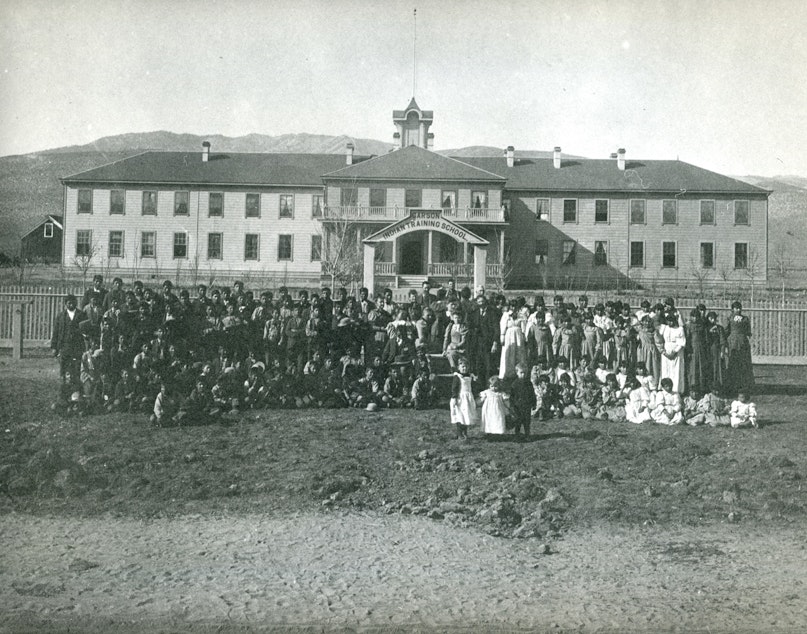Nevada Indian Commission Head On Residential School Deaths In U.S.: 'Shocking' But 'Known All Along'

The director of the Nevada Indian Commission says she’s relieved that Interior Secretary Deb Haaland — the country’s first Native American Cabinet secretary — is calling for an investigation into the more than 350 church-run residential schools for Indigenous children that operated in the United States from the 1880s to the 1990s.
Children were brought to these government-mandated institutions to be assimilated into non-Indian culture. Haaland’s announcement comes on the heels of Canada’s recent discoveries of undocumented mass graves containing the remains of more than 1,000 children on the grounds of that country’s residential schools, which were modeled afer those in the United States.
Stacey Montooth, director of the Nevada Indian Commission, says the creation of the schools came soon after the U.S. government passed the Civilization Fund Act in 1819. The intent, she says, was to culturally assimilate Indigenous children by preventing them from speaking their own languages, taking part in traditions, and making them feel ashamed of their culture.
The forcible removal, she says, would be called “kidnapping” in 2021.
Montooth is a member of the Walker River Paiute Tribe and Gov. Steve Sisolak’s liaison to Nevada’s 27 Native tribes. She’s collecting information about the Stewart Indian School as part of Haaland’s investigation — a job made more meaningful by the fact that her relatives were among those removed to the school.
Sponsored
Montooth says some of those relatives, including her grandmother, were as young as 4-years-old when they were pried away from their families. At the school, she says, they were treated as though they’d joined the U.S. military: Their hair was cut. They were issued uniforms. They were subjected to physical punishment and mental torture.
The abuse and trauma “… forever changed the lives of not just the first people of the Great Basin but Indigenous people all over the country,” Montooth says.
As a direct descendant of the Stewart Indian School and a Paiute woman, Montooth says that she cannot refer to these institutions as schools since they imparted little education to the thousands who attended them.
“This was a strategy that was very well thought out by the federal government and the tactic to remove a generation by attacking the women, the children to destroy a family unit,” she says.
Montooth’s grandmother was ashamed of her language and culture by the time she left the Stewart School after 15 years, Montooth says.
Sponsored
The recent call to investigate U.S. boarding schools is an opportunity for Indigenous people like her grandmother to heal, Montooth says. These investigations can help people tackle the physical and mental anguish they endured in the schools, she says.
“My family needs an acknowledgement from the United States government that they knowingly did this,” she says, “and that they understand that it was not just wrong, but that it is still impacting our Indigenous people today.”
Though Montooth’s own grandmother suffered at the schools, Montooth still hasn’t been able to have some of the hardest conversations with her, particularly about whether bodies might be discovered in mass graves.
Montooth explains that her grandmother’s emotional wrought from years at the school sometimes makes it “physically impossible” for them to discuss those memories.
“Most Americans would have a tough time reconciling the fact that every boarding school in the country had a cemetery on the campus grounds or nearby,” she says. “For Native American people, it’s so commonplace that the discovery of the remains of these little babies in Canada’s residential schools … it’s shocking, but it’s something we’ve known all along.”
Sponsored
Montooth says she’s seen more than 200 unmarked graves at the cemetery located next to the Stewart Indian School. And based on her observations, she says there’s no doubt the investigations launched by the secretary of interior will have similar outcomes to those in Canada.
“Americans don’t want to know that their federal government sanctioned the annihilation of not just any group of people, but it’s the people that were the first caretakers of the land,” she says, adding that her people are the most marginalized and oppressed people in the U.S.
Montooth says these investigations are an opportunity for Americans to galvanize around a tragic episode in the country’s history that has not yet been fully acknowledged.
“It’s going to change the course of the future of how not just American Indians in this country — but Indigenous people all over the planet — are treated,” she says. “It’s such a painful story but it’s got to be told.”
Karyn Miller-Medzon produced and edited this interview for broadcast with Todd Mundt. Camila Beiner adapted it for the web with Miller-Medzon.
Sponsored
This article was originally published on WBUR.org. [Copyright 2021 NPR]
